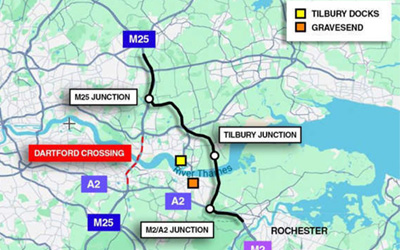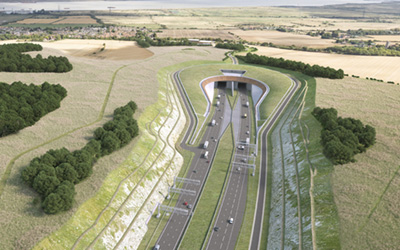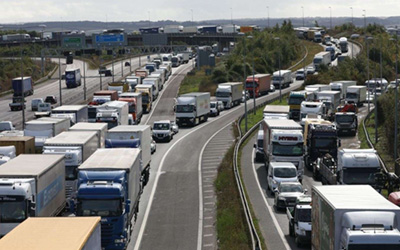Lower Thames Crossing: Tackling Congestion & Unlocking Growth
In today’s fast-paced world, efficient transportation is critical to economic growth and the quality of life for millions. The proposed Lower Thames Crossing is more than just a new road; it is a visionary project designed to transform the way people travel east of London.
Connecting Kent and Essex via a tunnel beneath the River Thames, the scheme aims to almost double the road capacity over the river, alleviate chronic congestion, and create far-reaching benefits for local communities and the national economy. In this comprehensive blog post, we explore every facet of the Lower Thames Crossing project, examining its design, benefits, latest news, community investments, and the promising future it heralds for UK transport infrastructure.
Introduction
Transportation infrastructure projects are often at the heart of regional growth, and the Lower Thames Crossing is no exception. With congestion levels reaching critical points and demand for sustainable transport solutions growing, this project represents a crucial step forward in modernising the country’s road network.
As the UK navigates its post-pandemic recovery, investments like these are vital in unlocking economic potential, reducing travel times, and supporting the evolving needs of residents and businesses alike.
This article takes an in-depth look at the Lower Thames Crossing project, drawing from official sources and the latest news to provide you with an authoritative overview. We will cover the project’s background, its expected benefits, the sustainability targets it is setting, and how it will impact communities along the route.
Understanding the Lower Thames Crossing Project
Overview
The Lower Thames Crossing is a proposed major infrastructure development that aims to establish a new connection between Kent and Essex. This new route is envisioned as a tunnel beneath the River Thames, specifically designed to handle increased traffic volumes and ease the burden on existing routes.
 By almost doubling the capacity of road crossings east of London, the project will offer a reliable alternative route that is expected to transform daily commutes and freight transportation.
By almost doubling the capacity of road crossings east of London, the project will offer a reliable alternative route that is expected to transform daily commutes and freight transportation.
The project is not only about easing congestion; it represents a strategic investment in the future of UK transport infrastructure. With rapid urban expansion and increasing economic activity in the region, the Lower Thames Crossing is set to become a vital artery that supports growth, connectivity, and improved accessibility.
Route and Design
Innovative Tunnel Design
One of the key highlights of the Lower Thames Crossing is its innovative tunnel design. Instead of building a conventional bridge, the project will see the creation of a tunnel that runs beneath the Thames. This approach is designed to minimise visual and environmental impact on the surrounding landscape while providing a robust and weather-resistant solution to traffic congestion.
The tunnel’s design is at the cutting edge of engineering, incorporating state-of-the-art safety features, ventilation systems, and emergency response mechanisms. These features ensure that the tunnel is not only efficient but also secure, addressing the safety concerns that naturally arise with underground infrastructure.
Strategic Connectivity
The location of the Lower Thames Crossing is strategic it directly addresses the traffic bottlenecks that have long plagued the east of London. By connecting two key regions, Kent and Essex, the project is expected to provide a much-needed alternative route for commuters, freight operators, and local businesses. This enhanced connectivity will reduce travel times, lower fuel consumption, and ultimately contribute to a reduction in carbon emissions.
Future-Proof Infrastructure
A significant aspect of the project is its forward-thinking design. The Lower Thames Crossing is being developed with the future in mind, ensuring that it remains a valuable asset for decades to come. The infrastructure is designed to be adaptable, capable of accommodating emerging technologies such as smart road systems and electric vehicle charging stations. This future-proofing is essential as the transportation sector continues to evolve with new innovations in sustainable travel and connectivity.
Key Benefits and Impact
The Lower Thames Crossing project is poised to deliver a multitude of benefits that extend far beyond just easing road congestion. Here, we delve into the key advantages that this ambitious scheme brings to the table.
Tackling Congestion Head-On
One of the most compelling reasons for developing the Lower Thames Crossing is its potential to drastically reduce congestion. East of London, road users have long experienced the frustrations of crowded routes and lengthy delays. By nearly doubling the available road capacity across the Thames, this project is expected to relieve some of the heaviest traffic bottlenecks.
 Improved Traffic Flow
Improved Traffic Flow
With the additional capacity, drivers will benefit from smoother traffic flow and less stop-and-go driving. This improved efficiency not only reduces travel times but also minimises the stress associated with long commutes. The reduction in congestion is likely to have a positive impact on the overall quality of life for residents in the surrounding areas.
Economic Benefits Through Time Savings
Time is one of the most valuable resources for both individuals and businesses. By cutting down on journey times, the Lower Thames Crossing will contribute significantly to economic productivity. Reduced congestion means that goods can be transported more swiftly, and workers can spend less time in transit, ultimately leading to higher productivity levels and a boost in the regional economy.
Unlocking Economic Growth
The project is much more than a road improvement—it is a catalyst for economic growth. The enhanced connectivity provided by the Lower Thames Crossing is set to unlock new opportunities for development, commerce, and investment in the region.
Facilitating Business Expansion
Businesses operating in Kent, Essex, and the greater London area will benefit immensely from a more reliable transport link. The improved road network can stimulate local economies by attracting new investments, encouraging the establishment of new businesses, and facilitating easier access to markets. This connectivity is expected to drive job creation and support the growth of key sectors such as logistics, retail, and manufacturing.
Regional Integration and Urban Development
The Lower Thames Crossing also plays a crucial role in fostering regional integration. By bridging the gap between Kent and Essex, the project encourages a more balanced distribution of economic activities across the region. This kind of integration helps reduce the over-reliance on a single urban center and promotes more sustainable patterns of urban development. Over time, enhanced infrastructure can lead to the creation of new residential and commercial hubs, further diversifying the regional economy.
Community and Environmental Benefits
Infrastructure projects of this scale are often accompanied by broader community and environmental benefits. The Lower Thames Crossing is designed to deliver positive outcomes in these areas as well.
Environmental Sustainability
One of the standout features of the Lower Thames Crossing project is its commitment to sustainability. The scheme has set a challenging target to reduce its carbon footprint, with the latest sustainability report highlighting an ambitious 70% carbon target. This makes the project one of the greenest road constructions planned in the UK. The design incorporates energy-efficient technologies, environmentally friendly materials, and sustainable construction practices, ensuring that the long-term environmental impact is minimised.
Moreover, by reducing congestion and facilitating smoother traffic flow, the project indirectly contributes to lower vehicle emissions—a significant advantage in the fight against climate change.
Enhancing Local Communities
The benefits of the Lower Thames Crossing extend to local communities as well. Improved road connectivity can lead to enhanced access to services, education, and healthcare for residents. The project is also expected to create a range of employment opportunities during the construction phase and beyond. Additionally, initiatives tied to the project, such as the restoration of heritage sites like the Tithe Barn in Upminster, underline the commitment to preserving local culture and history while driving modernisation.
Investment in Community Projects
In line with its broader goals, the Lower Thames Crossing project has also prioritised community investment. For instance, local initiatives such as biodiversity projects at places like Curtis Farm in Essex and heritage centres are receiving support. These efforts help ensure that while the project drives economic growth and improved connectivity, it also reinforces the social and environmental fabric of the communities it touches.
Latest Developments and News
Lower Thames Crossing update keeping abreast of the latest developments is essential when discussing a project as dynamic as the Lower Thames Crossing. Recent news highlights have underscored several key milestones and initiatives that are setting the stage for the project’s future.
Sustainability Initiatives: A Greener Road Ahead
In the latest updates from early February 2025, the Lower Thames Crossing project has raised the bar with its 70% carbon target. This ambitious goal is a testament to the project’s commitment to net zero challenges and environmental responsibility. The improved carbon target was detailed in the project’s second annual sustainability report, underscoring how modern infrastructure can be both effective and environmentally conscious.
This move not only aligns with national environmental goals but also sets a benchmark for future infrastructure projects in the UK. The integration of energy-efficient construction practices, renewable energy sources, and advanced materials is expected to make the Lower Thames Crossing one of the greenest road projects in the country.
 Government Backing and Chancellor’s Support
Government Backing and Chancellor’s Support
Political support plays a critical role in the realisation of large-scale infrastructure projects. On January 29, 2025, the Chancellor of the Exchequer reaffirmed the government’s commitment to delivering the Lower Thames Crossing. This endorsement is crucial as it signals strong financial backing and a clear policy direction from the highest levels of government.
The Chancellor’s backing is particularly significant in today’s economic landscape, where infrastructure investments are seen as pivotal to driving economic recovery and long-term growth. By prioritising the Lower Thames Crossing, the government is not only addressing immediate congestion issues but is also laying the foundation for sustained regional development and improved quality of life for future generations.
Community Heritage Projects: Restoring the Past for a Brighter Future
While modern infrastructure projects often focus solely on technological and economic benefits, the Lower Thames Crossing project has also taken steps to preserve and celebrate local heritage. An excellent example of this is the work that started on January 24, 2025, to rescue the historic Tithe Barn in Upminster. One of London’s oldest buildings is being restored with 30 tonnes of reed in a project that highlights the delicate balance between progress and preservation.
Such initiatives illustrate that while the project is paving the way for a modern transport future, it is equally committed to honouring and restoring the cultural landmarks that define the region’s rich history.
This balance of old and new is vital in ensuring that development projects do not come at the expense of local identity and heritage.
Investing in Communities
Infrastructure development is intrinsically linked to community growth and social prosperity. The Lower Thames Crossing project is designed with an understanding that improved connectivity can yield widespread benefits for local communities.
Local Economic Benefits
Improved road networks often act as catalysts for local economic development. The Lower Thames Crossing is expected to stimulate business growth by providing faster and more reliable transport links. Local businesses will gain access to new markets, and the ease of movement will reduce logistics costs, thereby enhancing competitiveness.
In addition to the direct benefits of improved traffic flow, the project is poised to create a multitude of jobs both during the construction phase and in subsequent phases of maintenance and operation. This influx of employment opportunities can lead to a boost in local economies, supporting everything from small businesses to large-scale industrial operations.
Social Infrastructure and Community Facilities
Beyond economic growth, improved transportation links can lead to better social infrastructure. Enhanced connectivity means that residents will have quicker access to schools, hospitals, and community centres. This improved access can be particularly transformative in rural and semi-urban areas where such facilities might otherwise be spread out over long distances.
Furthermore, the community investment aspects of the Lower Thames Crossing project extend to environmental and cultural initiatives. Projects aimed at restoring natural habitats, preserving historical sites, and promoting local tourism are integral components of the scheme. These initiatives ensure that while the project drives modernisation, it also enriches the community’s social and cultural life.
Looking Ahead: The Future of the Lower Thames Crossing
The journey to transform the Lower Thames Crossing from concept to reality is well underway, and the future holds exciting prospects for the project.
Upcoming Phases and Milestones
The development of the Lower Thames Crossing is being carried out in clearly defined phases, each with its own set of milestones. These phases include detailed planning, design finalisation, and the commencement of construction work. As the project progresses, additional updates and milestones will be communicated to keep the public informed about its development.
The phased approach not only allows for rigorous planning and execution but also ensures that the project can adapt to any challenges that arise along the way. Whether it is addressing environmental concerns or incorporating the latest technological advancements, the development strategy for the Lower Thames Crossing is both flexible and robust.
Long-Term Impact on UK Infrastructure
In the long run, the Lower Thames Crossing is poised to have a transformative impact on the UK’s transport network. By significantly enhancing connectivity in one of the country’s most critical regions, the project will serve as a blueprint for future infrastructure developments. Its innovative design, commitment to sustainability, and focus on community benefits set a high standard that can inspire subsequent projects across the nation.
Furthermore, the project will likely have a ripple effect, encouraging similar investments in other regions.
As urban areas continue to grow and the need for efficient transport solutions becomes increasingly urgent, the Lower Thames Crossing could serve as a catalyst for a broader modernisation of the UK’s road network.
FAQ
 Q: What is the Lower Thames Crossing?
Q: What is the Lower Thames Crossing?
A: The Lower Thames Crossing is a proposed new road that aims to connect Kent and Essex via a tunnel beneath the River Thames. It is designed to almost double the existing road capacity east of London, providing a critical alternative route that will ease congestion and support economic growth.
Q: How will the project reduce congestion?
A: By providing an additional, reliable route across the Thames, the Lower Thames Crossing will divert traffic from overburdened existing road networks. This increased capacity will lead to smoother traffic flow, shorter journey times, and a significant reduction in congestion-related delays. The improved efficiency will benefit both everyday commuters and freight operators.
Q: What environmental considerations are being addressed?
A: Environmental sustainability is a core component of the Lower Thames Crossing project. The scheme has set a robust 70% carbon reduction target, making it one of the greenest road projects in the UK. The design incorporates sustainable construction practices, energy-efficient technologies, and measures to minimise disruption to local ecosystems. These initiatives ensure that the project contributes positively to environmental conservation and supports the nation’s net zero objectives.
Conclusion
The National Highways road for the Lower Thames Crossing is poised to make a lasting impact on the region’s connectivity, economic landscape, and environmental footprint. As infrastructure projects continue to evolve in response to modern challenges, the principles of innovation, sustainability, and community focus exemplified by the Lower Thames Crossing will undoubtedly serve as a guiding light for future developments. For further updates on this ground breaking project and join the conversation on how such initiatives can shape a more efficient and sustainable future for everyone, BIFA Link TV is a great place to catch the latest news.
SARR Logistics UK
With a legacy built on trust, backed by extensive experience, a global network, and a customer-centric approach, SARR Logistics UK emerges as the ultimate partner for all your supply chain needs. If you would like to know more reach out to us today and experience a seamless, efficient, and dependable shipping solution tailored to elevate your business. For further inquiries and to explore how SARR Logistics UK can help you contact our team.



 Improved Traffic Flow
Improved Traffic Flow
 Government Backing and Chancellor’s Support
Government Backing and Chancellor’s Support




